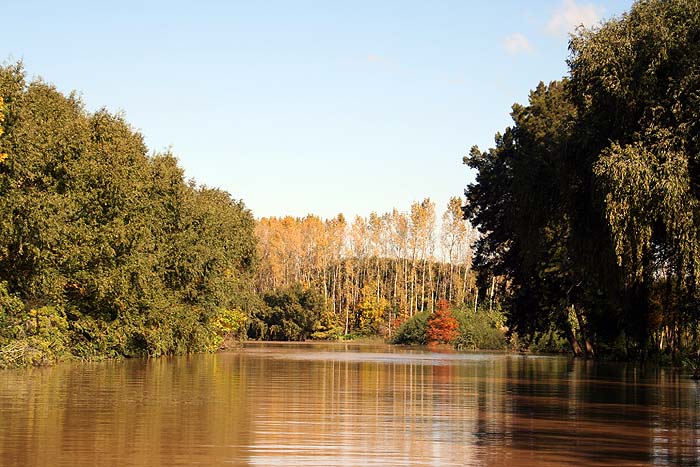There was a school party on the river bus. Chattering pupils, wearing life jackets as nonchalantly as British children might wear blazers, dumped their packs and got out cards. White-coated teachers studied their payslips.
I leant on a warm ledge of varnished wood and reflected upon my last visit to the Tigre, the delta suburb of Buenos Aires, when I had naively hopped on a tour boat for an hour or two before going to meet someone in town. I got back five hours later.
Mounting panic had ruined any pleasure in the passing scenery: the elegant rowing clubs lining the Río Luján, the weeping willows and scarlet ceibo blooms on the river banks, even the supremely faded hotel El Tropezón.
I know now that it could have been far worse. The delta is vast, almost 3,860 square miles. It's a Unesco biosphere reserve. I could have been gone for weeks.
The Río de la Plata, which flows into the Atlantic between Uruguay and Argentina, is fed by tributaries of the Paraná. These form the delta: millions of low, wooded islets, often flooded in both directions, courtesy of the Brazilian marshlands and the south-east winds.
Freshwater, labyrinthine and about 20 miles north of the city, it has always been a refuge: for smugglers from Uruguay, for 19th-century city dwellers fleeing yellow fever, for the rich fleeing the summer heat. My grandmother used to come dancing at Tigre Boat Club, where the dance floor undulates because of the floods. The delta had Argentina's first casino.
This time I could sit back and enjoy it. My cousins were taking me to a hotel in the second section of the delta, 90 minutes from the port of Tigre. They rented a little house here last summer: "You're really in the middle of nature," they said.
The long river bus, or lancha colectiva, turned its varnished nose into the Río Luján - glimpses of the 1896 Tigre Sailing Club and the half-timbered, Anglo-Norman façade of the Club La Marina - then north into the Arroyo Sarmiento (an arroyo is a small river).
We passed half-sunken boats and little cabins set among trees and, bizarrely, the wooden house of Sarmiento - the president inspired by a visit to the Mississippi delta to encourage fruit and timber production in Argentina's delta - encased in glass for protection.
The boat chugged along, leaving a long V in the fudge-coloured water. It stopped obligingly at private jetties, usually occupied by a delta dog, the sort that lies in the sun and raises a worldly eyebrow, yawns and goes back to sleep.
The schoolchildren hopped off at slightly unkempt islanders' houses (the smarter ones are usually weekend homes).
When we got to Los Pecanes, named for its tall pecan trees, we were the last people on board. The stilted house, with its corrugated roof and screened veranda, sat peacefully in the sun. Hammocks hung between the trees.
"My father bought it in 1959 and we used to come for holidays," said Richard Baert, who owns it with his wife, Ana. "We turned it into an inn in 1998. You've missed Ana. She's gone into town to get things and won't be back until tomorrow."
My cousins set off in canoes. I read in a hammock. Richard asked if we would like to visit El Dorado, a fishing club on the other bank. "It has always been a bit more pink gin than fishing," he said with a grin. "I'll show you - I know a window we can climb through."
Thwarted by the cleaning lady, who let us in at the door, we explored. The names on the boards - Chalk, Longstaff, Bradbury - had caught dorado and surubí, fish with oddly dog-like faces. Somebody caught one weighing 22kg (48lb) in 1938. These days, the larger fish have retreated up-river.
The aboriginal inhabitants caught fish, grew maize and hunted deer. They feared a wild cat, the yaguareté, now extinct in the delta (the last was seen years ago, floating downstream on a clump of detritus). It left its name behind: "tigre" [tiger].
In 1865 the train arrived, so when yellow fever struck Buenos Aires, those who could afford to fled to the Tigre. The mansions they built later became fine summer homes.
By the early 20th century, the place was swinging. Young things flocked to the Tigre Hotel (long demolished) and El Tropezón (now closed). Eighty thousand people worked on fruit farms and timber concessions. There was a floating school, a floating police station - with chapel - and a floating artist on a homemade boat. Then the fruit market collapsed.
Numbers are now building again. We could see the estate agents' signs as we puttered back the next day. Developers are building barrios cerrados (secure communities) and the weekend housing market is booming.
We could also see signs of local government largesse: the Tigre riverside has been spruced up; the old railway station is now a tourist centre; and the Tigre Club is due to re-open as a cultural centre in October.
I wandered about, peering through hedges at the rambling houses. One or two are hotels or b&bs. Some are private. Many are sailing or rowing clubs. I was trying to work out why it is so charming.
In the end I decided that it was simply its proximity to Buenos Aires: an unexpected, dreamy, half-forgotten wilderness, right on the city's back doorstep. It's a treat.

Sophie Campbell visits the Tigre Delta
All categories
- Any category
- Films (10)
- Guide books (20)
- History (16)
- LF blog (18)
- Music (2)
- News (74)
- Newsletters (42)
- Novels (14)
- Press articles (41)
- Press releases (22)
- Recipes (8)
- Riding (7)
- Travel books (19)
- Trip reports (84)
- Webinars (2)
All countries
- Any country
- Antarctica (7)
- Argentina (49)
- Belize (7)
- Bolivia (9)
- Brazil (48)
- Chile (42)
- Colombia (12)
- Costa Rica (27)
- Cuba (5)
- Ecuador (17)
- El Salvador (7)
- Falkland Islands (3)
- Galapagos (24)
- Guatemala (11)
- Guianas (11)
- Honduras (3)
- Mexico (19)
- Nicaragua (11)
- Panama (11)
- Paraguay (3)
- Peru (33)
- Uruguay (15)
- Venezuela (17)
